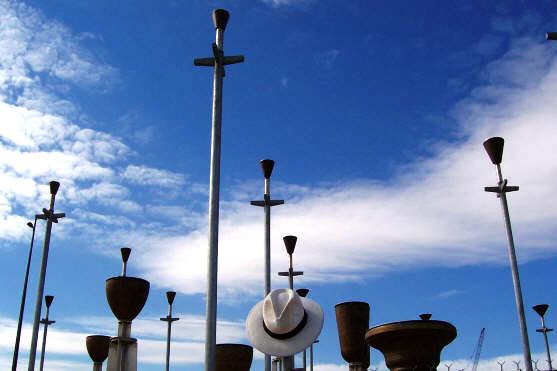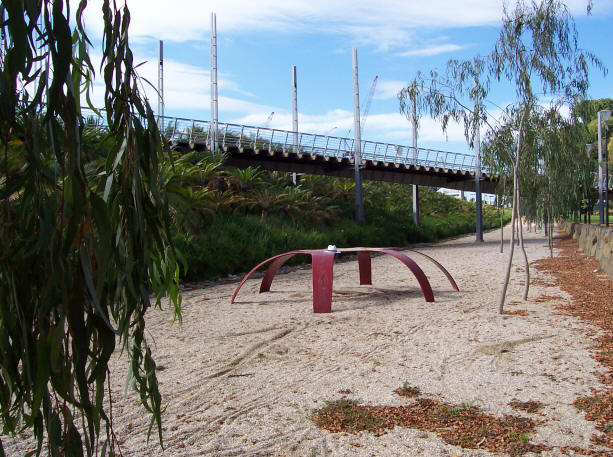Birrarung Marr
During the 20th century, the railyards next to the river
gradually expanded and cut that part of the city off from the river.
To compound this, several utilitarian (no - let's not beat around the bush -
ugly) public service buildings were erected which blocked the
view of the river. Melbournians had talked about what they could do about
these eyesores for the best part of a century. Then in the 1990s Victoria
got a government that wasn't big on talking, but was big on doing.
They decided to knock down the offending buildings, cover a large section of
the railyards to create
Federation Square
and free up a large section of riverside for additional parkland - now
Birrarung Marr. (That government also did other things which angered
enough voters to unceremoniously kick them out of office soon afterwards.)
The resulting park is quite modern in style and forms a contrast with the
parks from a century earlier on the
other side of the Yarra.
The first response might be to wonder what a large expanse of finely
ground gravel is doing in a park. However that is there to cater for major
events such as circuses and to carry the large amount of foot traffic to and
from the MCG and Tennis Centre. There are two large grassy terraces that are
suitable for picnics or just reading a book. These provide a unique view of
the city - the hustle and bustle of street level is masked out allowing the
upper structure of some of the better modern buildings of Melbourne to take
on an aura of dignity and calm. Buildings like
Harry Seidler's Shell
Building which turns its back on the city and faces out can be
appreciated in a way that was not possible before.
The gullies and pathways are also aligned to focus on city landmarks like
St Patrick's Cathedral, St Paul's Cathedral, The Rialto Towers, 101 Collins
Street and the Arts Centre Spire.

Federation Field of Bells - Birrarung Marr
Walking and cycling paths run through the park, including a 1.5km
circuit suitable for jogging and providing an alternative to "the tan" on
the other side of the river. Some paths have been designed to be suitable
for for beginning or endings of fun runs, marathons and the like.
Perhaps the strongest contrast Birrarung Marr presents to its stately
Edwardian sisters over the river is its ecological sensibilities. Australia
is a dry continent, and the European style gardens on the south of the river
require large amounts of water for their maintenance. The modern park is
planted with hardy natives that need little watering and the gullies (or
swales) are designed to catch and filter the water from the large runoffs
and return them to the aquifer. The soak and the gravel area perform a
similar function.

Crushed shell path at Birrarung Marr
There are several features which link it with the past. Some are tokenism
- eg the small soak is "a billabong which pays homage to the history of the
Yarra River". However, that is no bad thing. Similarly, an old railway
building of no particular merit compared with other examples around
Melbourne has been retained. Why? Melbournians are justly suspicious of
knocking anything down - particularly after the removal of heritage in the
50s, 60s and 70s. Hence we tend to cling to anything more than 30 years old,
even if it is to be replaced by something better and more significant. (If
Sydneysiders had this attitude they would still have a grungy old tram shed
on Bennelong Point rather than the Opera House.) So we have an old railway
building converted into a children's activity centre called ArtPlay.
However, the area that has the strongest resonances of the past is
Speakers Corner. The speakers mounds are where you could find orators of all
persuasions at the weekend. They had their heyday from the late 19th century
through to the 1930s. Here the crowds would mill around people spouting
anything from inspired oratory to arrant nonsense. (A sad and pale parody of
this can now be witnessed on the lawns of the
State Library
on Sunday afternoons - but be warned the speakers are often foul mouthed.)
Colourful characters like Chummy Flemming had their own mounds and he
eventually had his ashes scattered there. The remaining mounds (several of
them have been moved and reconstructed) underneath the elms are a reminder
of earlier, and sometimes violent times.
As for the name, we are told that the two words "Birrarung" and "Marr"
come from the Woiwurrung language of the Wurundjeri tribe of aborigines who
originally inhabited the land. They mean "river of mists" and "side of a
river". I don't speak the language - nor to my knowledge does any other
living soul - so I am prepared to accept this name as a belated recognition
of the original dwellers in this area. However, the local Aborigines are
said to have played a subtle trick on we whitefellas when it came to naming
our main festival. Maybe they have done the same again. Who knows? I
certainly don't. There is a certain irony in this naming because, of course,
this is not "side of the river" that the original aboriginal inhabitants
knew. The Yarra Yarra flowed through the area which is now the Botanic
Gardens and the ornamental lake there is part of the original river. With
flood control works in the 19th century the colonials altered the course of
the Yarra and the park is therefore on the banks of the new artificial
channel created by the Europeans.
In the meantime, I often wander through the park and ponder many aspects
of Melbourne's history both before and after European settlement.
In October 2004, Birrarung Marr won the
Walter Burley Griffin
Award for Urban Design.
Some forthcoming events at Birrarung Marr:
|
Melbourne Night Noodle Markets
The Night Noodle Markets are back, with all the sights, sounds and smells
of an Asian hawker market plus the buzz, hype and vibe of an outdoor
festival.
|
|
|
|
Moomba Fireworks
The annual Moomba Fireworks running over three nights.
|
___________________
 ___________________
___________________